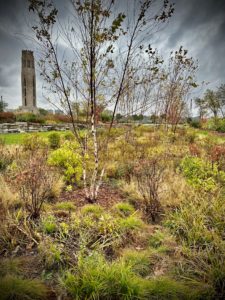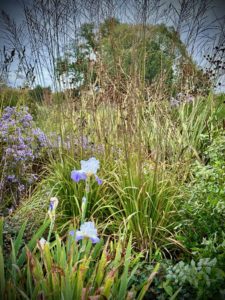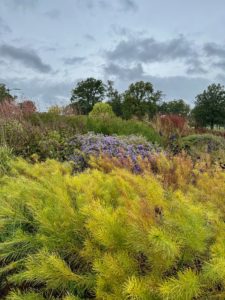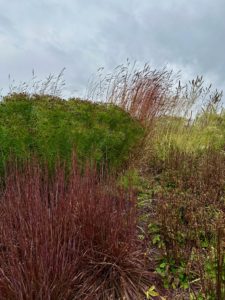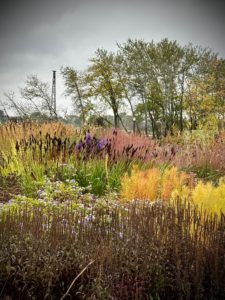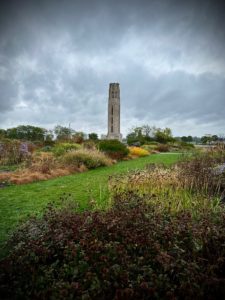Kat Kinch takes the train to the Oudolf Garden Detroit:
On a blustery October day in 2023, I made my way with a gang of garden friends to the Oudolf Garden in Detroit, Michigan. Piet Oudolf’s designs were an early entry point for me in learning about garden design, and I added on to my Master Gardener studies at Dalhousie with the prairie landscapes course, which stemmed from the instructor’s own interests in the breezy, grassy, sweeping patchworks of Oudolf’s work. I had already visited the rather modest entry garden he designed ages ago at the Toronto Botanical Garden, and had a chance to see his famous decades-old long border at RHS Wisley in England before it was razed to make way for a reinvented design that is now being built in its place. But I was most excited to see the Oudolf Garden in Detroit, having watched it take shape online during the pandemic and cheering on its opening in 2021.
The Bird Border at Oudolf Garden Detroit
The garden is set in a park area of Detroit called Belle Isle, nestled in the water with Canada on one side and America on the other. The three acre, volunteer-run garden site has a main garden, a rain garden, a “bird border” and meadow spaces still under development. During our visit, we heard about how the garden plans were swiftly shifted when the adjacent river flooded its banks during construction. The meadow areas will now be “wet meadows”, and the garden has recently made use of goats to knock back invasive plants in these areas.
During our autumn visit, the garden still boasted an impressive number of flowers, including statuesque irises and a second flush of pulsatilla blooms.
The most vivid colour came from Amsonia hubrichtii (thread leafed bluestar), which had turned brilliant yellow-green and waved its fine foliage en masse in the cold wind.
Amsonia hubrichtii in the wind
However, other stunning shades came from the surprising merlot lengths of Andropogon gerardii “Dancing Wind”and the deep tones of Schizachyrium scoparium “Smoke Signal”. These “nativars” of Big Bluestem and Little Bluestem were so strong ornamentally that they will be very popular once they become more commercially available (at least in my opinion), as they are much more attractive than stalwarts such as Karl Foerster grass but looked equally strong and durable.
Dancing Wind in the background, Smoke signal front left
The plant list also features a good range of straight species of North American native plants, including four kinds of milkweed, blue wild indigo, white wild indigo, turtlehead, showy tick-trefoil, boneset, bottle gentian, Canada anemone, and prairie smoke.
The garden is remarkably open source, with the plant lists and planting plans fully available online: https://oudolfgardendetroit.org/our-plants/
We also learned in our guided tour that one of reasons Piet Oudolf has been so successful as a designer of public gardens is due to the design fundamentals. Many of his gardens employ a “block plan”, in which multiple plants of one species are massed together in uniform shapes for strong visual effect – this makes such gardens easy to maintain by volunteers or non-horticultural staff, because they only need to weed out the non-matching specimens. The “grouping” designs maintain the masses of uniform plants, but vary the shapes more organically. The “matrix” designs are a step up in terms of complexity, but because the ground layer is uniform (in Detroit, with prairie dropseed as the base layer), the clumps of perennials stand out in their groupings within the matrix. The Oudolf Garden Detroit displays all of these kinds of designs, allowing for varying levels of expertise to assist in the garden’s ongoing maintenance.
Michigan shares many common plants, growing conditions and weather with us here in Southern Ontario, and for a little preview of what will be blooming here soon, be sure to check out the Oudolf Garden’s “Plants Now Blooming” section: https://oudolfgardendetroit.org/plants-now-blooming/ Based on what is in flower there now, I now that our pasqueflower, spicebush, and prairie smoke won’t be far behind!

